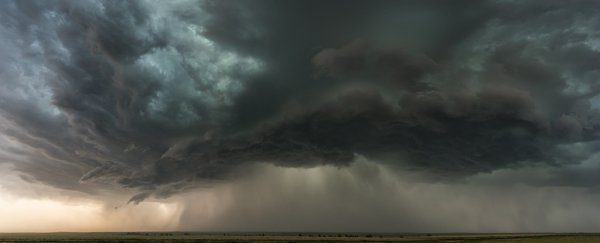In the distant past, Earth may have seen massive rain storms hundreds of miles wide, dumping more than a foot (over 30 centimeters) of rain in just a few hours.
Researchers have been modeling several epochs of extreme heat on our planet – times when the surface temperature would have been around 320 Kelvin (47 Celsius) – and think that cycles of dryness would've been swiftly followed by deluges of rain.
This cycle is a "new and completely unexpected atmospheric state" according to the team behind the new study. Not only can it improve our understanding of the past and future of Earth, it can also inform our observations of exoplanets outside of our Solar System.
"If you were to look at a large patch of the deep tropics today, it's always raining somewhere," says climate scientist Jacob Seeley from Harvard University in Massachusetts.
"But we found that in extremely warm climates, there could be multiple days with no rain anywhere over a huge part of the ocean. Then, suddenly, a massive rainstorm would erupt over almost the entire domain, dumping a tremendous amount of rain. Then it would be quiet for a couple of days and repeat."
The researchers produced a series of simulations, in some cases ramping up the temperature as much as 130 degrees Fahrenheit (54 degrees Celsius) hotter than it is on Earth at the moment. Both increases in atmospheric CO2 (up to 64 times current levels) and increases in the Sun's brightness were tested.
Temperature jumps of that magnitude create what's known as an "inhibition layer" – a layer near Earth's surface caused by heated atmospheric water vapor, which prevents convective clouds from rising and forming rain clouds. This layer then keeps evaporation trapped near the surface.
At the same time, heat being lost to space causes clouds to form in the upper atmosphere. Rain from these clouds evaporates before it hits the surface, because of the excessive heat, so the water in the system continues to build. This evaporation eventually breaks the inhibition layer, triggering a deluge that can last hours.
"It's like charging a massive battery," says Seeley. "You have a ton of cooling high in the atmosphere and a ton of evaporation and heating near the surface, separated by this barrier."
"If something can break through that barrier and allow the surface heat and humidity to break into the cool upper atmosphere, it's going to cause an enormous rainstorm."
In one simulation, the researchers observed more rainfall across six hours than some tropical cyclones drop in the US across several days. That's a lot of water. Once it's been released, the 'atmospheric battery' recharges and the cycle repeats.
The hothouse convection demonstrated in this study is similar in some respects to what is already seen in the Great Plains of the US, the researchers report, but on a much more dramatic scale.
As dire as the climate crisis is, no one is predicting such huge jumps in temperature for Earth at the moment. However, the research is important in understanding what Earth's climate is capable of, and mapping out our planet's future across millions of years – as the Sun continues to brighten.
"This study has revealed rich new physics in a climate that is only a little bit different from present-day Earth from a planetary perspective." says environmental scientist Robin Wordsworth, from Harvard University.
"It raises big new questions about the climate evolution of Earth and other planets that we're going to be working through for many years to come."
The research has been published in Nature.
